Ever tried to make steamed Japanese rice in an Instant Pot? This post will teach you an easy, fail-safe method for cooking perfectly plump and shiny short-grain white rice every single time with this popular electric pressure cooker!
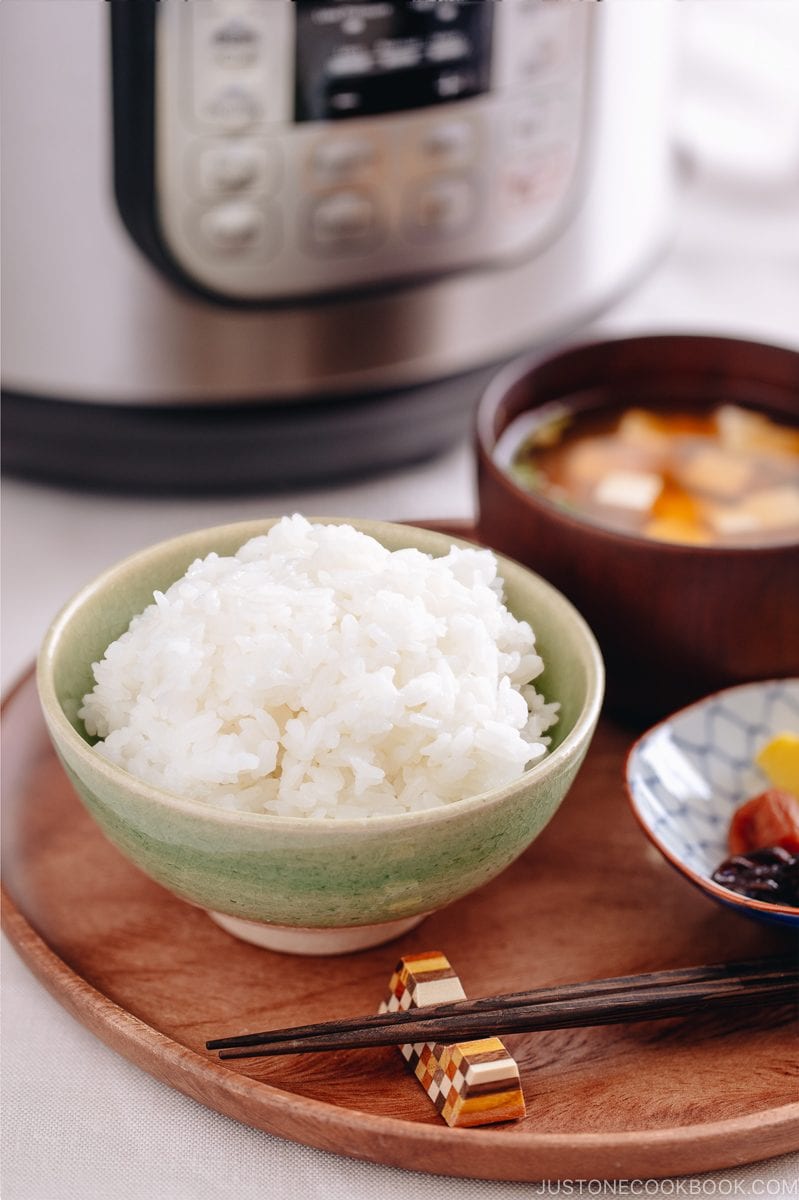
Steamed rice is an essential part of Japanese meal. If you don’t own a rice cooker but have an Instant Pot in your kitchen, you can definitely consider using this smart device to make rice for your Japanese dinner. Today we’ll go over how to make rice in an Instant Pot, along with some important tips that I’ve learned from my experiments.
The 3 Dilemmas Before Making Rice with the Instant Pot
Before I go straight to the Instant Pot Rice recipe, I want to tell you why it took me a long time to share this post. If you follow my blog for some time, you probably know that I have my Instant Pot for a while and I love using it to make various dishes.
But why haven’t I used my favorite Instant Pot to cook steamed rice? Here’s why I had avoided using the Instant Pot to cook rice:
1. The rice sticks to the bottom of the inner pot.
Having shiny, slightly sweet, plump, and delicious Japanese rice is true comfort and luxury for me, so I am willing to spend a little more to purchase short grain Japanese rice from Japan (currently enjoy rice from the Kyushu region). When I heard from others about rice sticking to the pot, I determined that I would not cook my precious rice in the Instant Pot. Not one piece of rice would go to waste in my house.
2. The Instant Pot is for the main dish.
Since I use the Instant Pot mainly to cook the main dishes, it’s impossible for me to use it to cook rice at the same time. Unless I am using two Instant Pots for this matter.
3. My Zojirushi rice cooker does an amazing job.
A rice cooker is an essential appliance in Japanese households. My Zojirushi Induction Heating Rice Cooker makes perfect rice every time, and I can even schedule the finished cooking time so the rice is always ready for dinner. That’s another reason why I didn’t need my Instant Pot to cook rice for me.
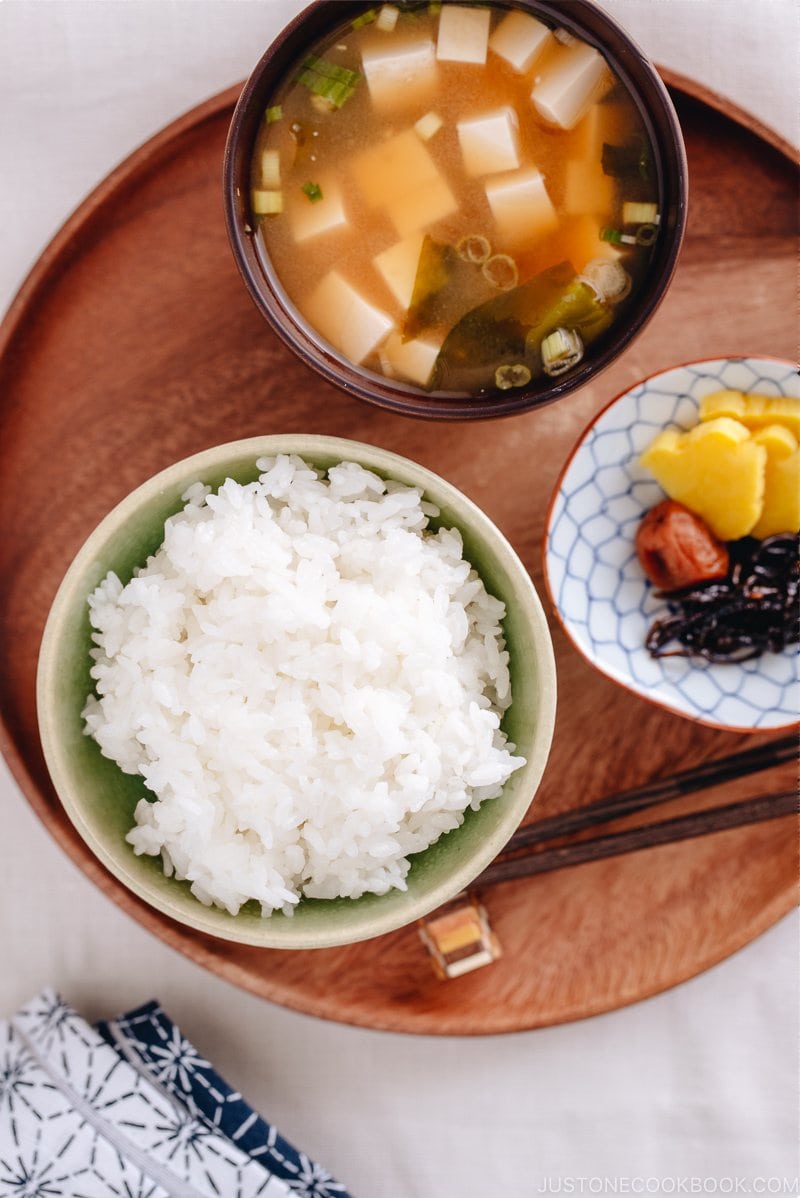
Finally, the Testing
For the past 3 years or so, I’ve received numerous requests from readers who wish to learn how to make perfect Instant Pot rice (pressure cooker rice). Some of you even wrote me a very personal email that I just felt that I had to give a try. After all, if I could save hundreds of people from wasting their rice, it’s worth my effort.
Please note: Different types of rice—such as jasmine rice, basmati rice, long-grain or medium-grain rice, wild rice, and brown rice—have unique characteristics and we can’t cook the rice the same way. The Rice I’m using in this recipe is Japanese short-grain rice.
Also, 1 cup of rice (240 ml) yields roughly 2 servings or 2⅓ cups of steamed rice.
To make the standard steamed rice, we do not flavor the rice with chicken broth or salt. The only exception is that we use a tiny bit of salt when cooking the brown rice.
I’ve tried two methods:
- Manual pressure cooking with different time periods and natural release timing.
- The preset “Rice” mode on the Instant Pot.
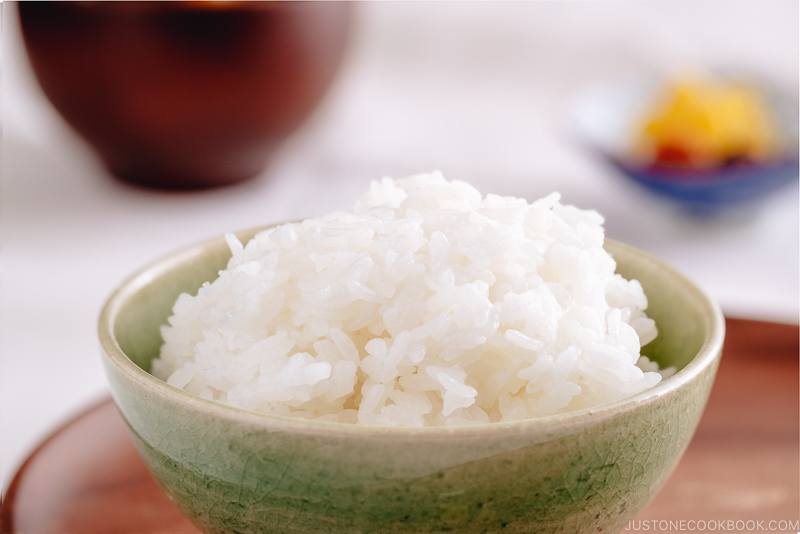
5 Most Important Tips to Make Japanese Rice in the Instant Pot
From my experience in cooking Japanese short-grain rice in my Instant Pot (pressure cooker), I learned 5 important tips. Here are my findings:
1. Soak rice for 20 minutes.
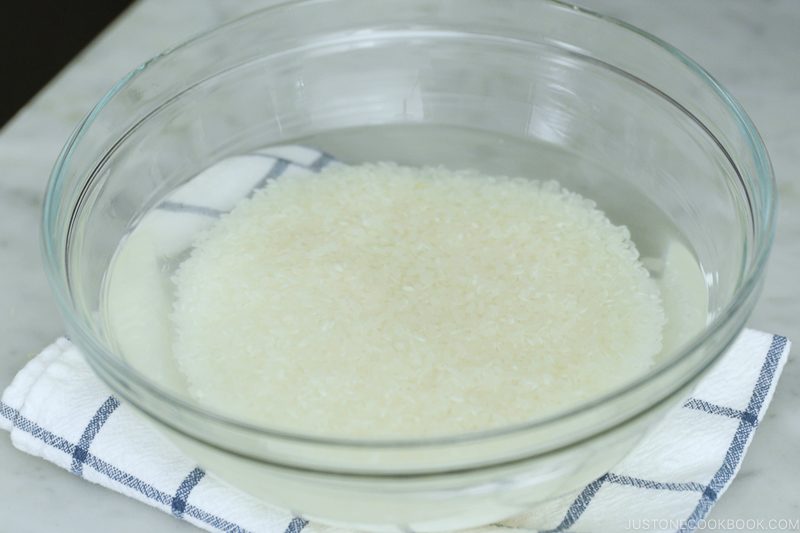
After you rinsed the rice, I tried both soaking rice and skipping soaking rice prior to cook rice in the Instant Pot. Whether it’s cooked in manual mode or “Rice” mode, when I didn’t soak rice, it did not become tender all the way through.
This is probably the only difference between cooking other types of rice. I often get asked why we need to soak Japanese short-grain rice. Unlike the other types of rice, Japanese short-grain rice is plump, and it takes time for the moisture to go through. Therefore, we always soak the rice first, giving the dry rice a head start in absorbing moisture.
2. Drain rice really well.
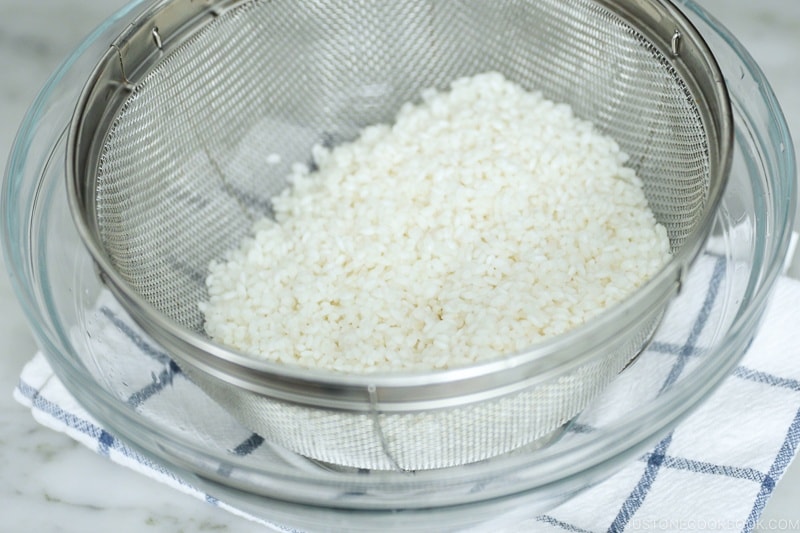
After soaking the rice in water, drain the rice into a fine-mesh strainer and make sure that the rice has no excess water left. If you don’t drain it well, you actually end up with more water while cooking the rice.
3. The ratio of water to rice is 1 to 1.
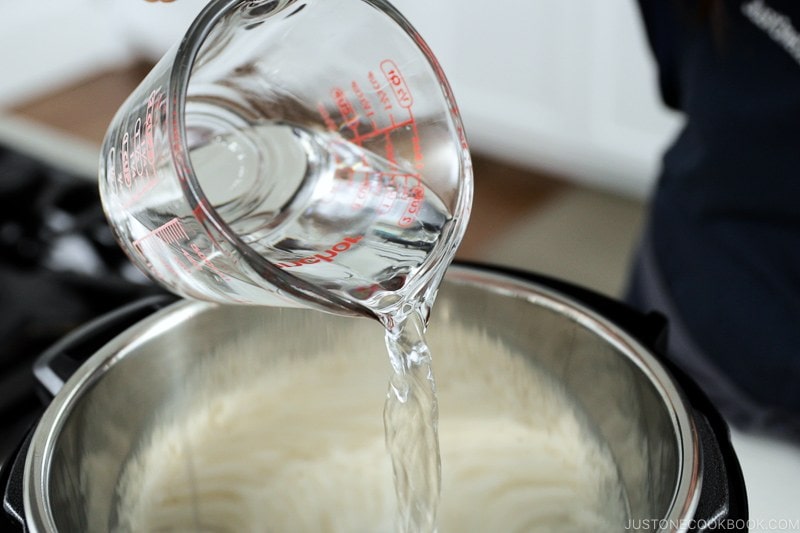
The golden rule for the ratio of Japanese short-grain rice to water is 1 to 1.1 or 1.2. So for 1 rice cooker cup (180 ml, 150 g), you will need 200 ml water.
However, when the rice is cooked in the Instant Pot, the steam does not escape from the pressure cooking (less evaporation). Therefore, the best water ratio is one to one: 1 cup of rice to 1 cup of water, or 1 rice cooker cup (180 ml) of rice to 180 ml of water.
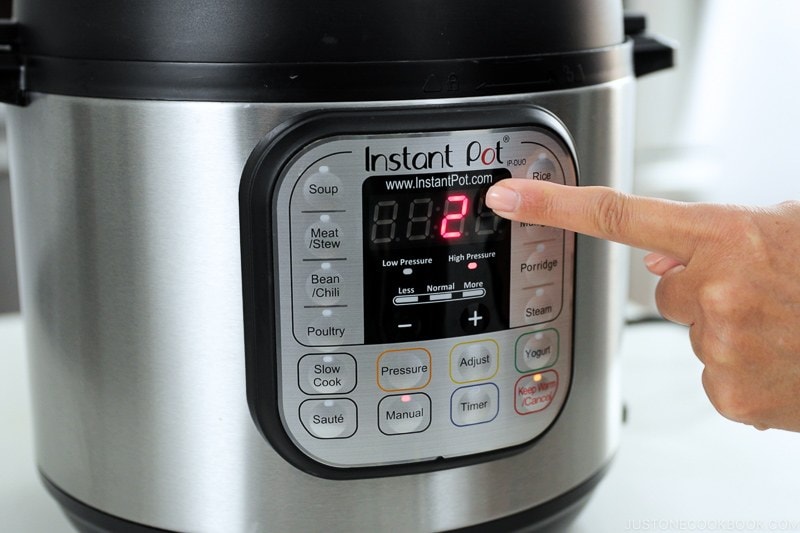
4. Cook at high pressure for 2 minutes.
After testing a few different variations, the best cooking time for short-grain rice is 2 minutes on high pressure. I’ve also tried using the “Rice” mode on the Instant Pot, which is set to 12 minutes on low pressure. As both manual and “Rice” mode takes 5 minutes to pressurize, “Rice” mode takes an extra 10 minutes to cook.
5. Natural release for 10 minutes and then release the pressure.
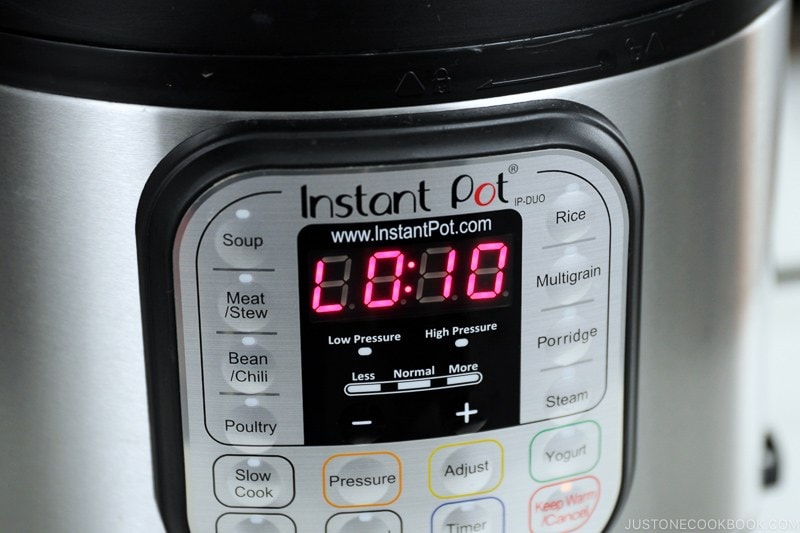
Because we do not want a “mushy” texture for rice, we must release the pressure from the Instant Pot after 10 minutes. The rice is still being cooked during this natural pressure release stage, but 10 minutes is plenty of time for the rice to finish cooking. After 10 minutes, there is not much pressure left, so you don’t need to worry about releasing the pressure. Don’t forget to fluff the rice with a rice paddle or fork.
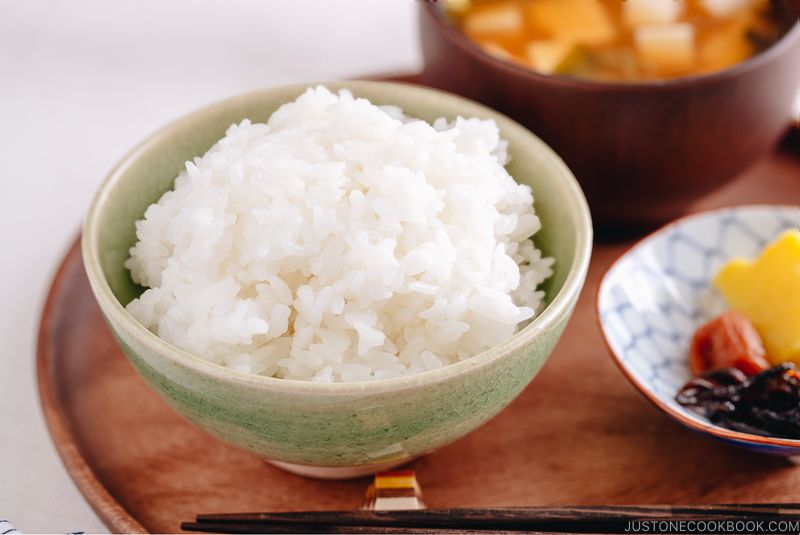
How to Store Cooked Rice
What’s the best method to store cooked rice? Simply freeze the rice in an airtight container and reheat it to enjoy the perfect Instant Pot Rice later on! This is by far the best approach to keeping your rice fresh and moist. Do not keep it in the fridge!
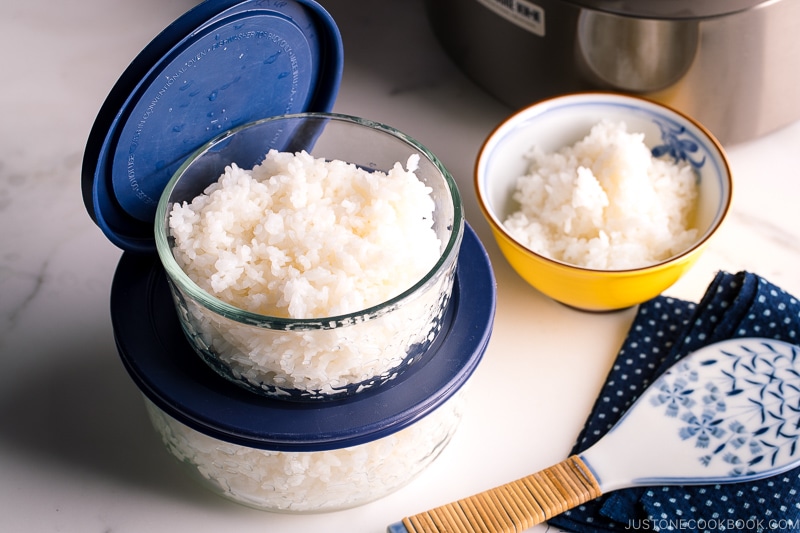
Final Thoughts
With the above methods and tips, you can make perfectly plump and shiny Japanese steamed rice in an Instant Pot. My personal preference is using the manual mode as it’s 10 minutes faster than the “Rice” mode and the texture of the rice was perfect.
Does the rice stick to the bottom of the pot? Well, surprisingly not when you open the lid right after 10 minutes of natural release. I can fluff up the rice nicely without any question.
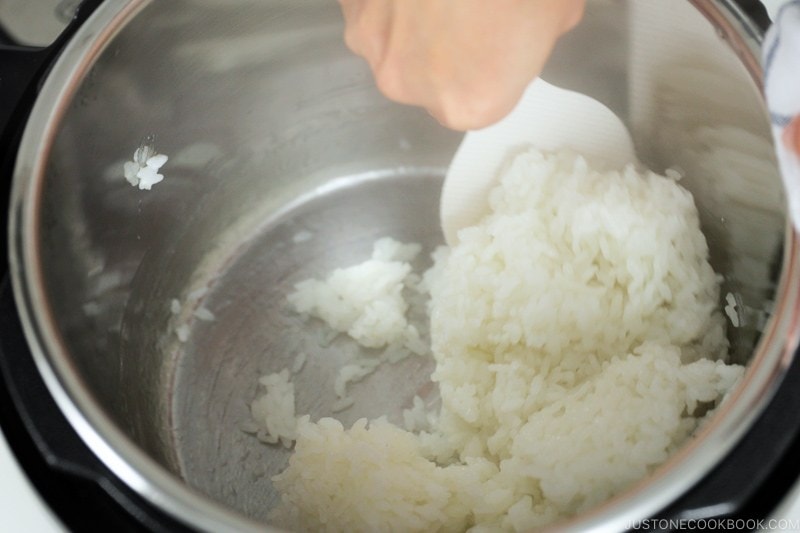
The only caveat is that you do have to serve or scoop out the whole pot of rice immediately after it is done cooking. There is enough moisture inside the pot that you can fluff and spoon out the rice smoothly without it sticking to the bottom.
However, if you leave the rice inside the inner pot for some time, the rice sadly sticks due to the starch in the rice. And it’s become a hassle to remove the remnants of cooked rice. You would end up having to soak the inner pot in water. It does come off clean eventually, but there is no way I could save the last piece of rice in the Instant Pot (Update: if you buy this non-stick inner pot, no more waste!).
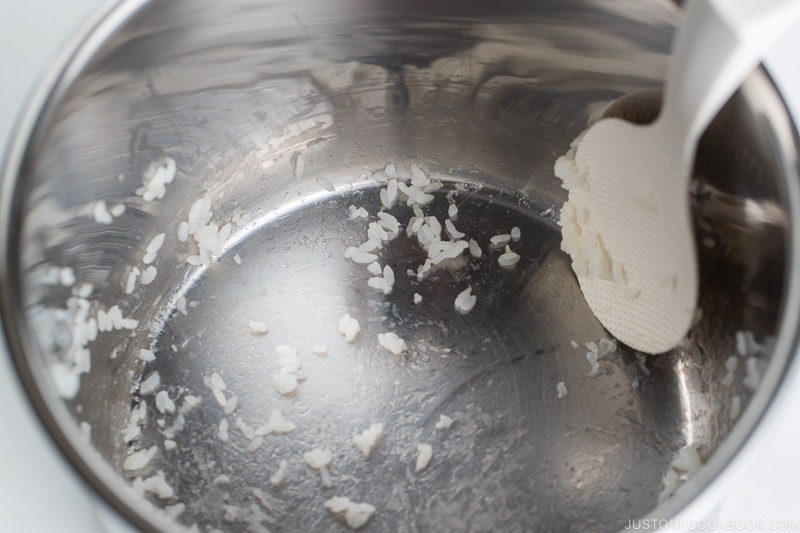
Would I continue to make rice in the Instant Pot? I would not, because I really don’t like wasting my rice. I prefer to cook the main dish in the Instant Pot and cook rice in the rice cooker. Two important appliances that could go hand in hand.
For those of you who are preparing main dishes with other cooking methods like roasting and pan-frying. you can definitely cook your rice in the Instant Pot. Maybe you don’t cook rice very often and prefer not to invest in a rice cooker. Or maybe you’re cooking a large batch of rice in advance for freezing purposes. Then go ahead to use the Instant Pot. That’s what this post is for, and I hope you find it useful.
Will you cook rice in the Instant Pot? Let me know in the comments below.
Other Rice Cooking Methods
- Cook Japanese rice in a pot on the stovetop
- Cook Japanese rice in a donabe on the stovetop
- Cook Japanese rice in a rice cooker
- Cook Japanese brown rice in an Instant Pot
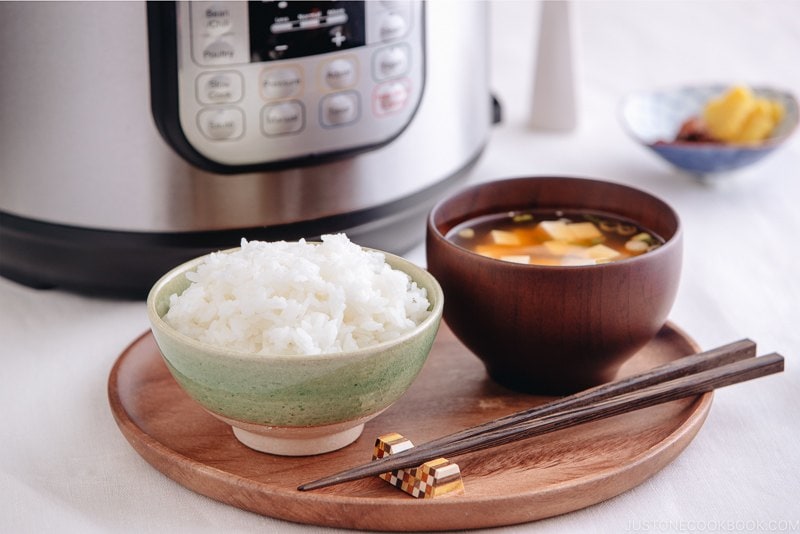
Wish to learn more about Japanese cooking? Sign up for our free newsletter to receive cooking tips & recipe updates! And stay in touch with me on Facebook, Pinterest, YouTube, and Instagram.
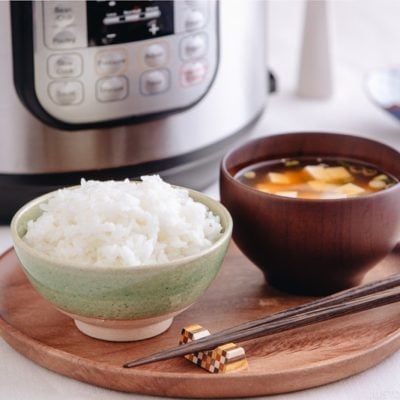
How to Make Japanese Rice in an Instant Pot
Video
Ingredients
For 4 Rice Bowls (4⅓ cups, 660 g)
- 1½ cups uncooked Japanese short-grain white rice (2 rice cooker cups, 360 ml)
- 1½ cups water (360 ml)
For 6 Rice Bowls (6⅔ cups, 990 g)
- 2¼ cups uncooked Japanese short-grain white rice (3 rice cooker cups, 540 ml)
- 2¼ cups water (540 ml)
For 8 Rice Bowls (8¾ cups, 1320 g)
- 3 cups uncooked Japanese short-grain white rice (4 rice cooker cups, 720 ml)
- 3 cups water (720 ml)
For 10 Rice Bowls (11 cups, 1650 g)
- 3¾ cups uncooked Japanese short-grain white rice (5 rice cooker cups, 900 ml)
- 3¾ cups water (900 ml)
Instructions
- Before You Start: Please note that Japanese short-grain white rice requires a soaking time of 20–30 minutes. The rice-to-water ratio is 1 to 1 when cooking short-grain white rice in an Instant Pot. Please read the blog post for more details. To cook short-grain brown rice, see my post on how to make Instant Pot Brown Rice.Also note that 1½ cups (300 g, 2 rice cooker cups) of uncooked Japanese short-grain rice yield 4⅓ cups (660 g) of cooked rice. This is enough for 4 Japanese rice bowls (typically 150 g each) or 6 onigiri rice balls (typically 110 g each). 1 cup of cooked rice weighs about 5.3 oz (150 g).
- Measure the Rice: Overfill a US cup measure (a ¾-cup measure works well for this) or a rice cooker cup with uncooked short-grain rice and level it off. Put the rice in a large bowl. Repeat until you have the measured amount of rice needed. Here, I‘m preparing 1½ cups (2 rice cooker cups, 360 ml) of uncooked white rice.
To Wash the Rice
- Quick Rinse: Add just enough tap water to the bowl to submerge all the rice. Then, discard the water immediately. Repeat one more time. Tip: Rice absorbs water very quickly when you start rinsing, so this step helps remove impurities from the rice and prevent it from absorbing the first few rounds of milky water.

- Wash: Next, use your fingers to gently agitate the wet rice grains in a circular motion for 10–15 seconds. Using very little water allows the grains to rub against each other. It also reduces the absorption of impurities from the starchy water.

- Rinse: Add tap water and immediately discard the cloudy water. Repeat one more time.

- Repeat Wash and Rinse (steps 2 and 3) two more times. When the water is almost clear, drain the rice well.
To Soak the Rice
- Soak: Add more tap water to the bowl to submerge the rice completely, and soak the rice for 20–30 minutes before cooking. Soaking is a must for short-grain rice! Here‘s how the rice looks before and after soaking for 20 minutes.

- Drain: After soaking, drain the rice in a fine-mesh sieve and set it aside for 10 minutes to drain completely. If you don’t have time to wait, then shake off the excess water the best you can.

To Cook the Rice
- Transfer the well-drained rice to the inner pot of the Instant Pot and add the measured water. Here, I'm adding 1½ cups (360 ml) water for my 1½ cups rice.

- Make sure the rice is level and evenly distributed in the pot. Close and lock the lid.

- Set the program to High Pressure for 2 minutes and it will automatically start cooking. Make sure the steam release handle points to Sealing and not Venting. The float valve goes up when pressurized, after about 5 minutes. When it’s finished cooking, the Instant Pot will switch automatically to the Keep Warm mode.Pressure Release: Let the pressure release naturally for 10 minutes. DO NOT EXCEED 10 MINUTES (I recommend setting a timer). After 10 minutes, quick release the remaining pressure: Place a kitchen towel over the steam release valve and turn the steam release handle to the Venting position until the float valve drops down. While only a little pressure should remain after 10 minutes of natural release, please take care not to place your hand or face over the steam release valve.

- Once you‘ve quick released the remaining pressure, open the lid. Fluff the rice with a rice paddle and serve warm.

To Store
- Transfer the warm rice to airtight containers and cover with the lids to keep the moisture in. Let cool completely before storing the containers in the freezer. The best way to store Japanese rice is to freeze, even if you use it the following day. Read my tutorial post.

Notes
- Rice Mode: 5 min (to pressurize) + 12 min (to cook on low pressure) + 10 min (let it steam)
- Manual Mode: 5 min (to pressurize) + 2 min (to cook on high pressure) + 10 min (let it steam)
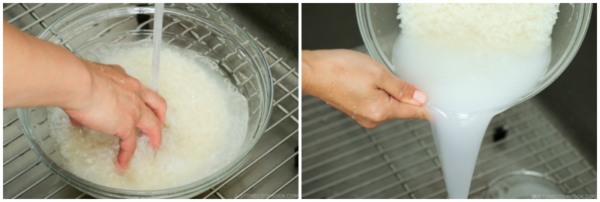
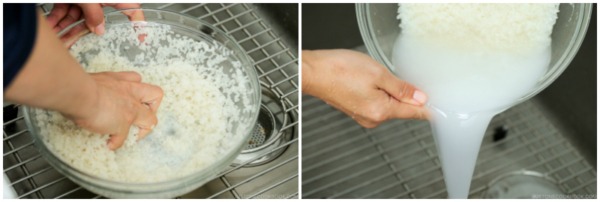
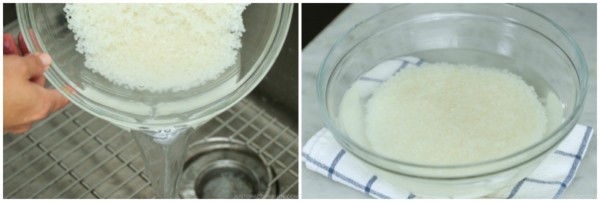
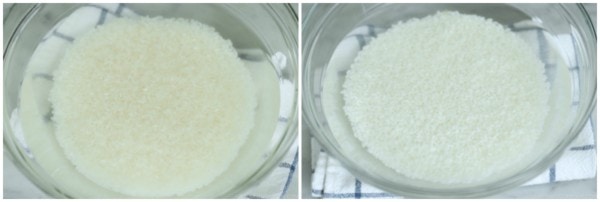
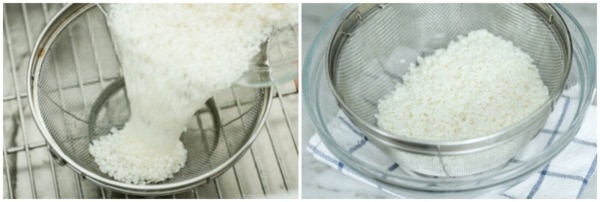
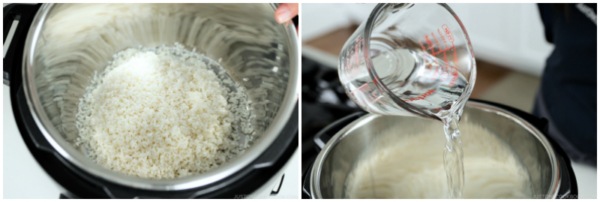
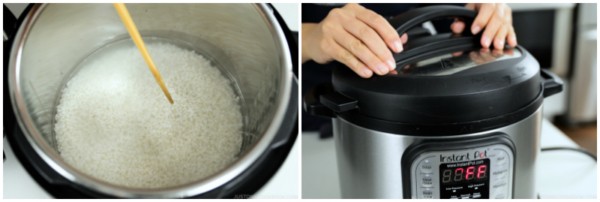
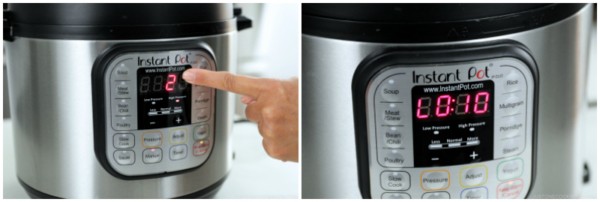
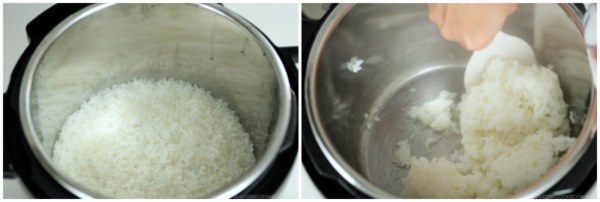
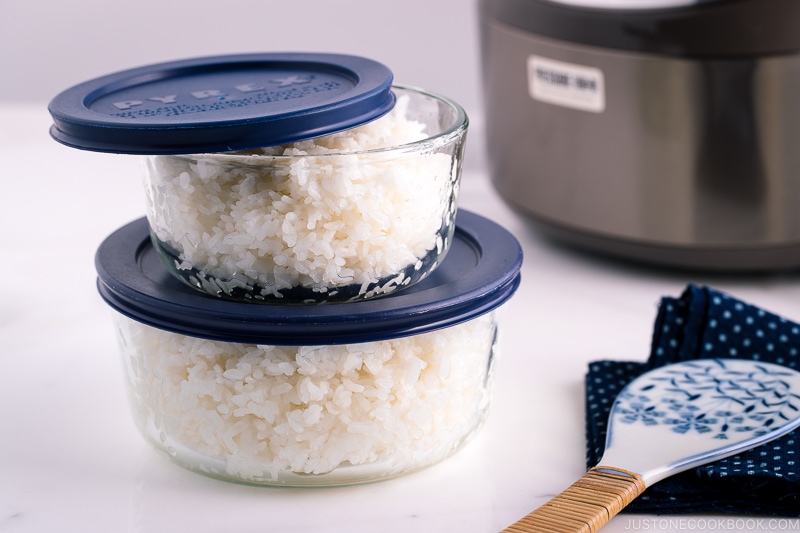










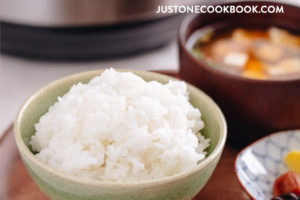
Worked perfectly for me! Thank you for sharing this method. Moving away from using toxic nonstick cookware so really appreciate this info. Will be using it daily.
Arigatoo!
Hello, Gean! We’re happy to hear you liked the Instant Pot approach.
Here are some additional quick recipes for you. We hope you like them.🙂
https://www.justonecookbook.com/how-i-use-instant-pot-for-japanese-cooking/
Thank you very much for trying Nami’s recipes!
I followed the recipe exactly and the short grained rice came out perfectly! Thank you!
Hello, Renee. Aww. We’re glad to hear that this method worked for you as well.
Thank you for trying Nami’s recipe and for your kind feedback!
Didn’t work for me unfortunately. Got the Burn Food code. I followed the directions for washing, soaking, and using 1:1 ratio rice:water. After the burn code, I added two more cups of water (so ultimately 1:2 ratio) because I didn’t want to ruin my pot- the non stick instant pot- or waste the rice since I figured that even if it turned out as rice porridge, the kids would eat it.
I love the clear and detailed instructions and photos and video which are all very high quality. I have used many, many recipes from this site, even every difficult and labor-intensive ones but this is the first one which didn’t work for me. Funny since it’s “just” rice! My mom told me that good rice is the hardest to make and that’s why sushi chefs study for 7 years just to make rice!
My Zojirushi is on the blink and my 30+yr old National is also finally not working right which is why I wanted to try the instant pot.
Hello Michelle, Thank you for giving Nami’s recipe a try. We’re sorry to hear that it didn’t turn out well for you.
Our recipes go through a many testing before we publish them using IP Duo, and we’ve never encountered the “burn” sign.
Could you check if your sealing ring is not damaged and if the float valve is clean and pointing to “Sealing” instead of “Venting”?
If you’re using the 6-quart, please ensure that you use at least 1 1/2 cups (375mL) of water in the recipe, as this is the minimum amount required for the Instant Pot.
We hope this information helps you, and we hope you will give it a try again.
I appreciate you trying the IP method but I’m with you on the rice cooker. The sticking at the end and the inability to thoroughly store rice for an extra day are not appealing. Short of someone not having one, why go through the extra trouble and steps to cook with an IP? Zojirushi rice cooker all the way. If it ain’t broke, don’t fix it.
Hi Malissa! Thank you for reading Nami’s post and for sharing your opinion. 🙂
This recipe worked great. I used 2 cups of Koshihikari rice and 2 cups of water. Soaked for 20 minutes and dumped the soak water. The brand I used said to let the rice soak in the water in the cooker and didn’t talk about cleaning and rinsing. I followed your recipe but scrolled through the instructions to do all the cleaning and rinsing in the beginning – whoops! But, it turned out very nice and went well with the amazake-soy chicken I cooked in the sous vide.
Hi Michael, Thank you for reading Nami’s post and trying her recipe!
We are glad to hear you enjoyed this recipe.
Some rice is a type called Musenmai 無洗米 and doesn’t require washing them. Maybe your Koshihikari rice was this type?
Nami explained in this post about different types of rice: https://www.justonecookbook.com/types-of-japanese-rice/
We hope this helps! 😊
Hello! I’ve been a big fan of your recipes for a while now. Unfortunately, my rice turned out all mushy and strange even after following all the steps. I used a 1:1 ratio of rice to water, so I’m not sure what I missed. Hopefully my next attempt will work out!
Hi Angel! Thank you for trying Nami’s recipe!
We are sorry to hear your rice turned out mushy. After you soak the rice in the water, did you drain the rice in a fine-mesh sieve? Make sure to shake off the excess water, so it will drain completely.😉
We hope this helps on your next try!
Hello! Thank you for this post ~ it’s extremely useful! I have a 6 quart instant pot. What is the most amount of white Japanese rice that I can make in it? Thanks in advance!
Hi Hannah, Thank you for reading Nami’s post and trying her recipe.
You can probably fit 4 cups (US Measuring Cup (240 ml) of rice and water to cook, but please make sure not to fill the inner pot more than 1/2 full.
We hope this helps!
Thanks so much for your time and effort with this recipe. I brought along an Instant Pot to our vacation rental – to use for making soup, but now I can have Japanese rice as well.
Marjorie
Hi Marjorie! Thank you for trying Nami’s recipe and for your kind feedback!
We are glad to hear that you found a new way to use your Instant Pot from our site.
Happy Cooking!
Hi there! Thanks for your tips. Am I reading this correctly that if I buy the non stick insert for the instapot that the rice won’t stick if left on keep warm? I’d like to have a pot of rice that’s warm and ready all day. Thanks!
Hi Zan! Yes! If you use a nonstick instant pot insert, the rice won’t stick! So you should be able to keep the rice warm.
Thank you for reading Nami’s post!
Hello. I used to have a very nice rice cooker but wore it out. I now have a Quick Cooker, Pampered Chef version of an Instant Pot. I did not like the way it cooked rice unless I made it in the ceramic pot that fits inside over the main dish. I can make main in bottom then rice in separate pot on top. It turns out perfect every time. I do rinse my jasmine rice as I always have. No soaking. I do miss my rice cooker but with the children grown and gone we only need two servings now anyway. Thank you for all your lessons. I am enjoying them and love making new recipes.
Hi Kathy! Thank you very much for reading Nami’s post and sharing your cooking experience with us.
The way you make rice sounds very clever. Thank you for sharing it.🙂
We hope you continue to enjoy many recipes from our site.